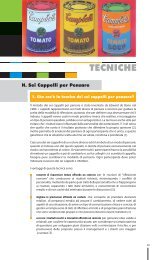Creativity Theory - TRaining MAterial in Creativity and InnovaTion ...
Creativity Theory - TRaining MAterial in Creativity and InnovaTion ...
Creativity Theory - TRaining MAterial in Creativity and InnovaTion ...
Create successful ePaper yourself
Turn your PDF publications into a flip-book with our unique Google optimized e-Paper software.
A. ESSENTIALS<br />
that supports <strong>in</strong>novation <strong>and</strong> creativity:<br />
it seems reasonable to suppose that<br />
<strong>in</strong>dividuals will engage <strong>in</strong> more creative<br />
processes if they perceive strong creative<br />
support from their work group. It is<br />
certa<strong>in</strong>ly true that employees who have<br />
<strong>in</strong>novation <strong>and</strong> creativity potential are<br />
more likely to practice <strong>in</strong>novation <strong>and</strong><br />
creativity when they perceive strong work<br />
group support than employees who perceive<br />
weak work group support. Also the<br />
manager’s role is very important <strong>in</strong> order<br />
to improve creativity <strong>in</strong> organizations: they<br />
have to direct <strong>in</strong>terventions at the subsystems<br />
1 . The <strong>in</strong>terventions should aim at<br />
sensitiz<strong>in</strong>g the organization to its change<br />
dynamics <strong>and</strong> should suggest ways of<br />
work<strong>in</strong>g. If successfully implemented, the<br />
<strong>in</strong>tervention will help cultivate creativity.<br />
Then, <strong>in</strong> order to cultivate <strong>in</strong>novation <strong>and</strong><br />
creativity <strong>in</strong> the workplace, certa<strong>in</strong> leadership<br />
behaviours should be practised. The<br />
ma<strong>in</strong> practices that leaders should embrace<br />
<strong>in</strong> order to support <strong>and</strong> encourage <strong>in</strong>novation<br />
<strong>and</strong> creativity <strong>in</strong> the workplace <strong>in</strong>clude:<br />
• Encourag<strong>in</strong>g employees to challenge<br />
the status quo;<br />
• Hav<strong>in</strong>g an open attitude towards risk<br />
tak<strong>in</strong>g;<br />
• Be<strong>in</strong>g able to use mistakes as learn<strong>in</strong>g<br />
opportunities;<br />
• Us<strong>in</strong>g <strong>and</strong> shar<strong>in</strong>g knowledge <strong>and</strong><br />
<strong>in</strong>formation;<br />
• Focus<strong>in</strong>g on cont<strong>in</strong>uous learn<strong>in</strong>g;<br />
• Conduct<strong>in</strong>g fair <strong>and</strong> <strong>in</strong>formative<br />
evaluations;<br />
• Reward<strong>in</strong>g creative performance;<br />
• Practis<strong>in</strong>g participatory management;<br />
<strong>and</strong><br />
• Be<strong>in</strong>g self-reflective<br />
All of these <strong>in</strong>terventions are directed<br />
at the people <strong>and</strong> management of the<br />
organizations. Intuitively, organizations<br />
recognize the importance of tra<strong>in</strong><strong>in</strong>g<br />
employees <strong>in</strong> creative skills <strong>in</strong> order to enhance<br />
creativity. However, creativity skills,<br />
without the necessary technical competence<br />
will not help <strong>in</strong>dividuals or groups<br />
to arrive at creative solutions to job-related<br />
problems. F<strong>in</strong>ally, there is a need for human<br />
relations tra<strong>in</strong><strong>in</strong>g. For example, employees<br />
should be tra<strong>in</strong>ed on basic communication<br />
skills such as active listen<strong>in</strong>g, giv<strong>in</strong>g <strong>and</strong><br />
receiv<strong>in</strong>g feedback, or, s<strong>in</strong>ce people will<br />
<strong>in</strong>evitably have to work <strong>in</strong> groups, team<br />
build<strong>in</strong>g programmes will also be helpful.<br />
In contrast, a focus on ma<strong>in</strong>ta<strong>in</strong><strong>in</strong>g the<br />
status quo fosters an unwill<strong>in</strong>gness to<br />
change the way <strong>in</strong> which th<strong>in</strong>gs are normally<br />
done <strong>and</strong> which can <strong>in</strong>hibit creativity<br />
<strong>and</strong> m<strong>in</strong>imize orig<strong>in</strong>al th<strong>in</strong>k<strong>in</strong>g <strong>and</strong> new<br />
ideas. Effective leaders must also be will<strong>in</strong>g<br />
to take risk <strong>and</strong> encourage risk tak<strong>in</strong>g<br />
amongst their employees. Furthermore,<br />
the practice of <strong>in</strong>volv<strong>in</strong>g the workforce<br />
<strong>in</strong> decision-mak<strong>in</strong>g can be a very effective<br />
way to <strong>in</strong>crease employee feel<strong>in</strong>gs<br />
of belong<strong>in</strong>gness, commitment <strong>and</strong> job<br />
satisfaction lead<strong>in</strong>g to enhanced creativity.



